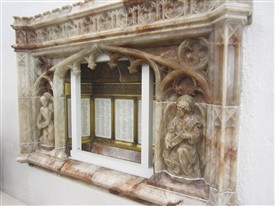Alabaster in Nottinghamshire

War Memorial of Derbyshire alabaster in the church of St.Helens, Bishopsgate, London EC3A
Photographed September 2014
An Introduction
Often small in scale, but intricate in detail, the alabaster carvings emanating from Nottinghamshire in the 14th and 15th centuries remain some of the best examples of the art in the world.
Alabaster is a form of gypsum (calcium suphate). It looks like marble, but is much softer and easier to work. Thereafter it hardens with exposure, conveniently 'fixing' the carving for evermore.
It is translucent white in colour but sometimes veined in red (recalling the tones of human flesh), and proved an ideal medium for fashioning devotional pieces and tombstone effigies. Even when hardened, however, it is still too easily worn to be suitable for outdoor sculptures. When looking for alabaster carvings or monuments, therefore, they will invariably be located indoors.
Historical background in Nottinghamshire
The main source of alabaster used by the Nottinghamshire craftsmen came from quarries at Chellaston, a little way over the county border in Derbyshire. Much of the output from Nottinghamshire craftsmen, however, was for export - to London and across Europe (see section on 'fingerprinting' below).
A good introduction to the history of alabaster carving in Nottinghamshire is give by George Fellows in his 'Arms, Armour & Alabaster around Nottingham' (Nottingham: H.B. Saxton, 1907). In it Fellows notes that the "finest material" came from Chellaston, from where it was probably conveyed down the River Trent to Nottingham.
Some bulky commissions are likely to have been worked in situ on the banks of the Trent at Chellaston, it being recorded for instance, that a Thomas Prentys and Robert Sutton, both decsribed as 'kervers' of Chellaston, made the alabaster altar tomb effigies of Ralph Green and his wife for Lowick in Northants (1419).
Considering the rough and uneven nature of roads in Medieval times, river transport was, no doubt, the preferred method of transporting these heavy, bulky - yet delicately carved - items; along the River Trent from Chellaston to Nottingham for the raw material, and then further downstream along the Trent to Hull for shipment around the coast to London or abroad.
Road transport, however, was clearly still an option as in 1530 we read of a William Walsh suing a John Nicholson (who is described as a 'stainer' - ie one who painted and gilded the figures) for carriage of a cartload of alabaster from Chellaston in Derbyshire to Nottingham - a distance of 14 miles.
Other places which are known to have been sources of alabaster lie in Nottinghamshire and include Gotham, Wheatley and Ratcliffe-on-Soar.
The Alabaster carvers
Fellows tells us that that the craftsmen who did the carvings could be referred to variously as 'alabastermen', 'marblers', 'image-makers' or 'kervers'.
Nottingham, says Fellows, enjoyed a considerable reputation for its skilful kervers, with their wares being exported across the country and abroad.
From the Nottingham Borough Records, 6th June 1371: Payment was made to Peter Maceon ['Peter the Mason'?] of Nottingham "of the balance of 300 marks for a table [altar piece] of alabaster made by him, placed upon the High-Altar within the free Chapel of St. George of Windsor". This large order required 10 carts, 80 horses and 20 men to transport it to its destination. The journey occupied 17 days in the autumn of 1367 and the expenses of transport amounted to £30.
From the Nottingham Borough Records, 1478: Nicholas Godeman - an "aleblasterer" - paid a fee of viii pence to follow his calling in the Borough.
From the Nottingham Borough Records, 1480: Nicholas Hill, image-maker, delivered 58 heads of St.John yjr Baptist, part of them being in tabernacles of niches.
From the Nottingham Borough Records, 31st Oct. 1491: Nicholas Hill took out an action against his salesman, Robert Tull, who had been engaged to convey images to London but had defaulted on payment.
The trade of the kerver met with a considerable check after the Reformation when anything in the nature of images was discountenanced.
'Fingerprinting' Nottinghamshire Alabaster
An article in 'The Times' (17th June 2014) headed "Revealed: the European love affair with British alabaster" confirms Nottinghamshire's once pre-eminent position in alabaster work, explaining how new scientific techniques are being used on carvings across Europe to reveal their origin through the stone's chemical 'fingerprint'.
And the story that is revealed shows that marble for a significant proportion of Europe's major ecclesiastical alabaster-work originated from Nottinghamshire.
Quoting from the work of Dr Kloppmann and his team as published in the journal Archaeometry*, the Times article cites the example of the remakable tomb of King Gustavus Vasa of Sweden in Uppsala Cathedral. Dr. Klopmann's team have here shown that, although carved by the Flemish master Willem Boy, the alabaster itself actually came fron near Newark in Nottinghamshire.
Although by the time Gustavus' tomb was being created (c.1560) it was mainly the raw material rather than carved alabaster that was exported from Notts, there are still some excellent examples of fine locally produced alabaster carvings to be found around the county.
* "Tracing Medieval and Renaissance Alabaster Works of art back to Quarries: A multi-Isotope (Sr, S, O) Approach" by W. Kloppmann et al, in Archaeometry Vol.56, Issue 2, April 2014, pp203-219.